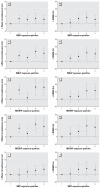Concentrations of urinary phthalate metabolites are associated with increased waist circumference and insulin resistance in adult U.S. males
- PMID: 17589594
- PMCID: PMC1892109
- DOI: 10.1289/ehp.9882
Concentrations of urinary phthalate metabolites are associated with increased waist circumference and insulin resistance in adult U.S. males
Erratum in
- Environ Health Perspect. 2007 Sep;115(9):A443
Abstract
Background: Phthalates impair rodent testicular function and have been associated with anti-androgenic effects in humans, including decreased testosterone levels. Low testosterone in adult human males has been associated with increased prevalence of obesity, insulin resistance, and diabetes.
Objectives: Our objective in this study was to investigate phthalate exposure and its associations with abdominal obesity and insulin resistance.
Methods: Subjects were adult U.S. male participants in the National Health and Nutrition Examination Survey (NHANES) 1999-2002. We modeled six phthalate metabolites with prevalent exposure and known or suspected antiandrogenic activity as predictors of waist circumference and log-transformed homeostatic model assessment (HOMA; a measure of insulin resistance) using multiple linear regression, adjusted for age, race/ethnicity, fat and total calorie consumption, physical activity level, serum cotinine, and urine creatinine (model 1); and adjusted for model 1 covariates plus measures of renal and hepatic function (model 2). Metabolites were mono-butyl phthalates (MBP), mono-ethyl phthalate (MEP), mono-(2-ethyl)-hexyl phthalate (MEHP), mono-benzyl phthalate (MBzP), mono-(2-ethyl-5-hydroxyhexyl) phthalate (MEHHP), and mono-(2-ethyl-5-oxohexyl) phthalate (MEOHP).
Results: In model 1, four metabolites were associated with increased waist circumference (MBzP, MEHHP, MEOHP, and MEP; p-values </= 0.013) and three with increased HOMA (MBP, MBzP, and MEP; p-values </= 0.011). When we also adjusted for renal and hepatic function, parameter estimates declined but all significant results remained so except HOMA-MBP.
Conclusions: In this national cross-section of U.S. men, concentrations of several prevalent phthalate metabolites showed statistically significant correlations with abdominal obesity and insulin resistance. If confirmed by longitudinal studies, our findings would suggest that exposure to these phthalates may contribute to the population burden of obesity, insulin resistance, and related clinical disorders.
Figures
Similar articles
-
Biomonitoring of phthalate metabolites in the Canadian population through the Canadian Health Measures Survey (2007-2009).Int J Hyg Environ Health. 2013 Nov;216(6):652-61. doi: 10.1016/j.ijheh.2012.12.009. Epub 2013 Feb 16. Int J Hyg Environ Health. 2013. PMID: 23419587
-
Phthalates and the diets of U.S. children and adolescents.Environ Res. 2013 Oct;126:84-90. doi: 10.1016/j.envres.2013.07.007. Epub 2013 Sep 13. Environ Res. 2013. PMID: 24041780
-
Occurrence and daily variation of phthalate metabolites in the urine of an adult population.Int J Hyg Environ Health. 2007 Jan;210(1):21-33. doi: 10.1016/j.ijheh.2006.09.005. Epub 2006 Dec 19. Int J Hyg Environ Health. 2007. PMID: 17182278
-
Urinary phthalate metabolites and semen quality: a review of a potential biomarker of susceptibility.Int J Androl. 2008 Apr;31(2):112-7. doi: 10.1111/j.1365-2605.2007.00844.x. Epub 2007 Dec 6. Int J Androl. 2008. PMID: 18067563 Review.
-
Possible impact of phthalates on infant reproductive health.Int J Androl. 2006 Feb;29(1):172-80; discussion 181-5. doi: 10.1111/j.1365-2605.2005.00642.x. Int J Androl. 2006. PMID: 16466537 Review.
Cited by
-
Environmental Obesogens and Their Perturbations in Lipid Metabolism.Environ Health (Wash). 2024 Feb 13;2(5):253-268. doi: 10.1021/envhealth.3c00202. eCollection 2024 May 17. Environ Health (Wash). 2024. PMID: 39474325 Free PMC article. Review.
-
Puberty in girls of the 21st century.J Pediatr Adolesc Gynecol. 2012 Oct;25(5):289-94. doi: 10.1016/j.jpag.2012.05.009. Epub 2012 Jul 27. J Pediatr Adolesc Gynecol. 2012. PMID: 22841372 Free PMC article. Review.
-
Nontraditional Risk Factors for Obesity in Modern Society.J Obes Metab Syndr. 2021 Jun 30;30(2):93-103. doi: 10.7570/jomes21004. J Obes Metab Syndr. 2021. PMID: 34011693 Free PMC article. Review.
-
Environmental Obesogens: Mechanisms and Controversies.Annu Rev Pharmacol Toxicol. 2019 Jan 6;59:89-106. doi: 10.1146/annurev-pharmtox-010818-021304. Epub 2018 Jul 25. Annu Rev Pharmacol Toxicol. 2019. PMID: 30044726 Free PMC article. Review.
-
Combined transcriptomic-(1)H NMR metabonomic study reveals that monoethylhexyl phthalate stimulates adipogenesis and glyceroneogenesis in human adipocytes.J Proteome Res. 2011 Dec 2;10(12):5493-502. doi: 10.1021/pr200765v. Epub 2011 Nov 9. J Proteome Res. 2011. PMID: 22017230 Free PMC article.
References
-
- Adams KF, Schatzkin A, Harris TB, Kipnis V, Mouw T, Ballard-Barbash R, et al. Overweight, obesity, and mortality in a large prospective cohort of persons 50 to 71 years old. N Engl J Med. 2006;355(8):763–778. - PubMed
-
- Andrade AJ, Grande SW, Talsness CE, Grote K, Chahoud I. A dose-response study following in utero and lactational exposure to di-(2-ethylhexyl)-phthalate (DEHP): non-monotonic dose-response and low dose effects on rat brain aromatase activity. Toxicology. 2006;227(3):185–192. - PubMed
Publication types
MeSH terms
Substances
LinkOut - more resources
Full Text Sources
Other Literature Sources
Medical
Miscellaneous


